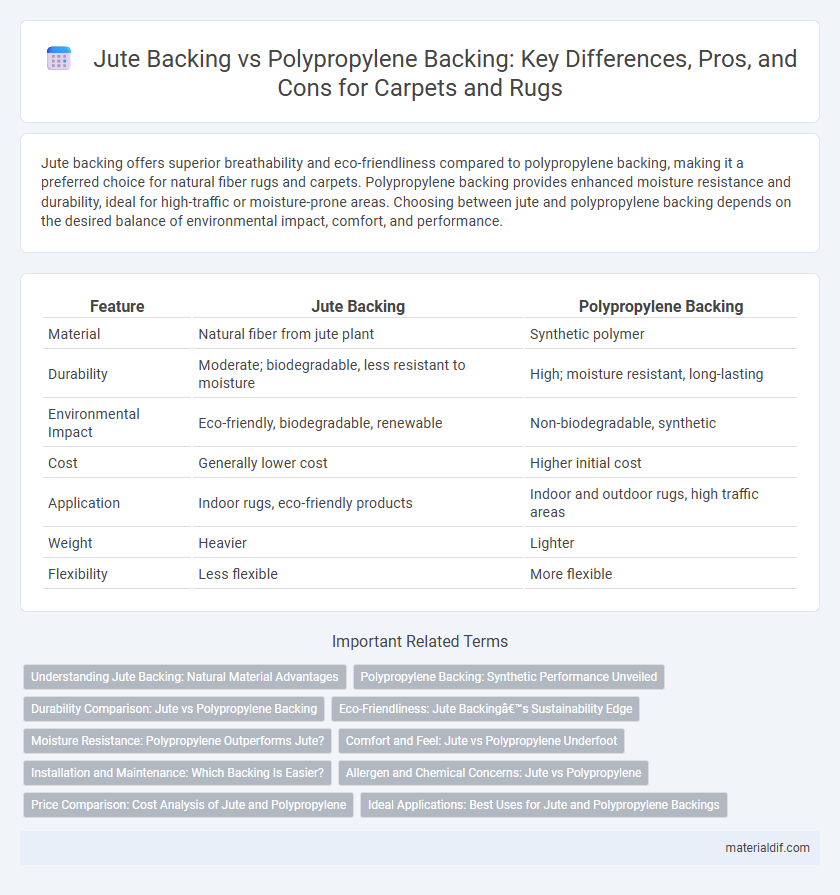Jute backing offers superior breathability and eco-friendliness compared to polypropylene backing, making it a preferred choice for natural fiber rugs and carpets. Polypropylene backing provides enhanced moisture resistance and durability, ideal for high-traffic or moisture-prone areas. Choosing between jute and polypropylene backing depends on the desired balance of environmental impact, comfort, and performance.
Table of Comparison
| Feature | Jute Backing | Polypropylene Backing |
|---|---|---|
| Material | Natural fiber from jute plant | Synthetic polymer |
| Durability | Moderate; biodegradable, less resistant to moisture | High; moisture resistant, long-lasting |
| Environmental Impact | Eco-friendly, biodegradable, renewable | Non-biodegradable, synthetic |
| Cost | Generally lower cost | Higher initial cost |
| Application | Indoor rugs, eco-friendly products | Indoor and outdoor rugs, high traffic areas |
| Weight | Heavier | Lighter |
| Flexibility | Less flexible | More flexible |
Understanding Jute Backing: Natural Material Advantages
Jute backing offers superior breathability and eco-friendliness compared to polypropylene backing, being a 100% natural, biodegradable fiber derived from plants. Its moisture-absorbing properties help prevent mold and mildew growth in carpets, enhancing indoor air quality and durability. The renewable nature of jute reduces environmental impact, making it a sustainable choice for eco-conscious flooring solutions.
Polypropylene Backing: Synthetic Performance Unveiled
Polypropylene backing offers superior moisture resistance and durability compared to jute backing, making it ideal for high-traffic areas and humid environments. Its synthetic fibers resist mold, mildew, and wear, ensuring a longer lifespan for rugs and carpets. Polypropylene backing also provides enhanced stability and prevents stretching or shrinking, maintaining shape and appearance over time.
Durability Comparison: Jute vs Polypropylene Backing
Jute backing offers moderate durability, ideal for low-traffic areas due to its natural fiber composition, but tends to degrade faster when exposed to moisture and heavy wear. Polypropylene backing provides superior durability and resistance to moisture, making it suitable for high-traffic and humid environments, while maintaining structural integrity over time. Choosing polypropylene backing enhances the longevity of carpets compared to jute, particularly in commercial or high-use settings.
Eco-Friendliness: Jute Backing’s Sustainability Edge
Jute backing offers superior eco-friendliness compared to polypropylene backing due to its natural, biodegradable fibers sourced from renewable plant resources. Unlike polypropylene, a non-biodegradable synthetic material derived from petroleum, jute decomposes quickly, reducing landfill waste and environmental impact. The sustainable cultivation and low-energy processing of jute further enhance its green credentials, making it the preferred choice for environmentally conscious consumers.
Moisture Resistance: Polypropylene Outperforms Jute?
Polypropylene backing offers superior moisture resistance compared to jute backing, making it an ideal choice for areas exposed to high humidity or spills. Jute, being a natural fiber, tends to absorb moisture, which can lead to mold growth and deterioration over time. The synthetic nature of polypropylene provides enhanced durability and longevity by resisting water absorption and preventing damage in damp environments.
Comfort and Feel: Jute vs Polypropylene Underfoot
Jute backing provides a natural, breathable foundation that enhances comfort underfoot with its soft, cushioning texture, making it ideal for areas where a warm, organic feel is desired. Polypropylene backing offers a firmer, more resilient surface that can feel less plush but provides increased durability and moisture resistance, suitable for high-traffic or damp environments. Choosing between jute and polypropylene backing depends on prioritizing a natural, comfortable feel or a durable, moisture-resistant backing in rug applications.
Installation and Maintenance: Which Backing Is Easier?
Jute backing offers a natural, breathable layer that simplifies installation by conforming easily to uneven surfaces, while its biodegradable nature requires careful maintenance to prevent moisture damage. Polypropylene backing provides a more durable, moisture-resistant base that resists mold and mildew, reducing long-term upkeep but can be more rigid and challenging to install on irregular floors. For ease of installation and minimal maintenance, polypropylene backing is generally preferred in high-humidity or heavy-traffic areas.
Allergen and Chemical Concerns: Jute vs Polypropylene
Jute backing is a natural fiber known for its hypoallergenic properties and low chemical content, making it a safer choice for individuals with sensitivities or allergies. Polypropylene backing, a synthetic material, may contain chemical additives and off-gas volatile organic compounds (VOCs), posing potential allergen and respiratory concerns for sensitive users. Choosing jute backing reduces exposure to synthetic chemicals, promoting a healthier indoor environment.
Price Comparison: Cost Analysis of Jute and Polypropylene
Jute backing typically costs more upfront due to its natural fiber sourcing and eco-friendly manufacturing processes, whereas polypropylene backing is generally cheaper, being a synthetic polymer produced from petroleum derivatives. Despite higher initial expenses, jute offers better durability and biodegradability, potentially reducing long-term replacement costs and environmental impact. Polypropylene's lower price makes it popular for budget-friendly applications but may involve higher ecological and disposal costs over time.
Ideal Applications: Best Uses for Jute and Polypropylene Backings
Jute backing is ideal for natural fiber rugs used in low-traffic areas, offering breathable support and eco-friendly benefits, making it perfect for living rooms and bedrooms. Polypropylene backing excels in moisture-prone environments such as basements, kitchens, and commercial spaces due to its water resistance, durability, and resistance to mold and mildew. Selecting jute ensures sustainability and aesthetic warmth, while polypropylene provides enhanced longevity and easy maintenance in high-moisture or high-traffic settings.
Jute Backing vs Polypropylene Backing Infographic

 materialdif.com
materialdif.com